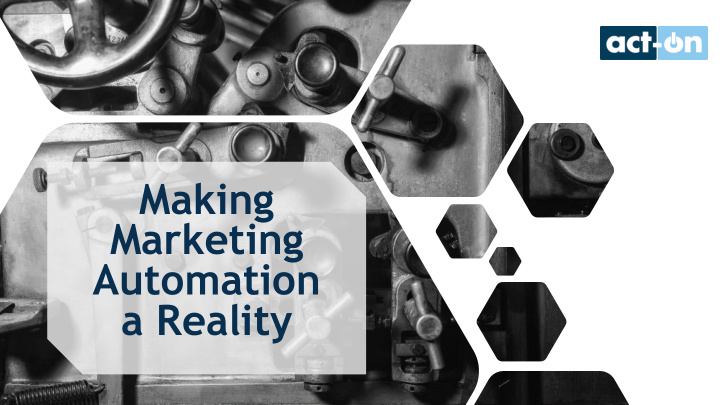



Making Marketing Automation a Reality
Katie Jameson , Director, EMEA Marketing, Act-On Software
Marketing automation is the central nervous system of the business
Stages of Making Marketing Automation a Reality Level 3 Adaptive Marketing Pros Level 2 Multi-channel Campaigners Level 1 Email Blasters ● Adapt at the individual & account level - e.g. multiple scoring models ● Enable sales reps to adapt - custom ● Multi-channel segmented strategy ● Email-centric, batch and blast CRM field sync, ABM, email templates, ● Behavior & profile segmentation etc. ● Manual efforts - scoring, data ● Automation of scoring, data management, GDPR compliance.. ● Analytics that help you adapt - guidance management & enrichment vs. report, BI tool support ● CRM integration lacking ● Key contact info sync’ed in CRM ● AI-driven learning/adapting from ● Minimal KPI reporting behavior data (including 3rd party) ● Funnel, campaign, attribution reports
of companies are using marketing automation, 55% either exclusively ( 21% ) or in addition to an email platform ( 34% ).
Marketers using MA see a 451% increase in qualified leads, which deliver 47% larger purchases than non-nurtured leads. Source: Annuitas Group
The majority of organisations say they need to improve their MA capabilities in all areas
7 KEY STEPS TO SUCCESS
1. Build the business case Understand your objectives and make sure they align with those of the business.
Marketing automation benefits Reduce costs Increase sales Improve CX and Better measurement and loyalty • Better alignment data • Faster sales cycles between sales and • Better marketing • Higher-quality More accurate • segmentation and reporting, and leads Reduced cost per • personalisation lead integration with analytics More targeted • A more consistent • Reduced need for • spending experience involvement of IT Better marketing • and data analysts attribution More brand • Less time spent • advocates Ability to build a • pursuing sub- SCV standard leads
2. Get buy-in from stakeholders You need senior management and heads of departments to understand and engage with what you’re doing — and to support it.
“We looked at our stakeholders directly under board level and at understanding how we could try and lobby them around how marketing activities enabled by this investment would benefit them.” Tim Creak Marketing Specialist, EMEIA Marketing Operations, Fujitsu
3. Understand the customer journey Set objectives and establish metrics for each step along the buyer’s path.
“It’s about measuring the engagement with that customer throughout the entire lifecycle, rather than just pinging out an email and having some nice stats pop out.” Lucy Dawson Co-Founder and Director, Ratio Creative
“By rooting MA in customer journey mapping and modelling, you have a much more joined- up approach … There is a shift away from campaign / content / channel optimisation toward customer metrics, whether those are NPS, customer lifetime value or referral and advocacy.” Andrew Campbell Martech Director, Customer Experience Division, Home Agency
4. Change the culture Make sure everyone understands and believes in the fact that the customer is now the focus of the business.
“What we are doing is understanding each of our major campaigns from a strategic perspective, and aligning them back to the sales growth objectives, or understanding how we can best support the sales targets.” Tim Creak Marketing Specialist, EMEIA Marketing Operations, Fujitsu
“You have to start at the top, and both sales and marketing have to believe in what you are trying to achieve. And there has to be benefit for both parties.” Lucy Dawson Co-Founder and Director, Ratio Creative
5. Choose your platform Understand the support available and look at the product roadmap. Think about which additional technologies you need to integrate (now and in the future).
Questions to ask potential suppliers 1. Scalability. Will the technology scale to meet your needs in the future? 2. Training. How much training will be needed across the organisation? How much support is available? 3. Reporting. Will your chosen platform produce reports that everyone in the business will understand ? 4. Integration. How easy is it to integrate your platform with the other martech products that you use or may want to use? 5. Future-proofing. What does the supplier’s roadmap for its platform look like, and does it match your company’s goals and ambitions?
What Marketers should demand from vendors in this new era CUSTOMER-CENTRIC FAST TIME INDIVIDUAL PHILOSOPHY TO VALUE PERSONALIZATION $ Value-based approach Like Facebook/Google; leveraging data Focus on Marketing ROI, guidance focused on when you from everywhere, supporting adaptive and support at every step engage customers marketing
6. Develop your capabilities and skill sets Choose whether a centre of excellence or widespread training and adoption suits you best.
Modern Marketing Model (M3) Capabilities in the ‘execution’ area of the Modern Marketing Model include: • Data & measurement • Integrated marketing communications • Distribution • Customer experience
7. Improve your data capabilities Establish best practices around the collection, cleaning, storage, and use of data.
“There is a great opportunity in MA to start to clean your data through expanding your forms and asking for different things at each stage, as people progressively get more engaged. It’s quite a nice, gentle way of doing it.” Lucy Dawson Co-Founder and Director, Ratio Creative
RECAP: How you can make marketing automation a reality 1. Build the business case. 2. Get buy-in from stakeholders. 3. Understand the customer journey. 4. Change the culture. 5. Choose your platform. 6. Develop your capabilities and skill sets. 7. Develop your data capabilities. www.act-on.com/reality
www.act-on.com/reality Questions?
Making Marketing Automation a Reality
Recommend
More recommend